Housing statistics quarterly update: December 2021
A summary of activity in new build housing, affordable housing and long term empty properties and second homes in Scotland.
7. Affordable housing supply
Affordable Housing Supply Programme statistics reflect the broader supply of affordable homes (i.e. for social rent, affordable rent and affordable home ownership) and include off the shelf purchases and rehabilitations as well as new builds. Statistics are available up to the end of September 2021.
Quarterly affordable housing supply statistics are used to inform progress against Scottish Government affordable housing delivery targets, including to deliver the remaining 50,000 target homes as quickly as it is safe to do so over the year 2021/22, along with the longer term ambition to deliver 110,000 affordable homes by 2032, of which at least 70% will be for social rent and 10% will be in remote, rural and island communities. The statistics reflect the number of affordable homes delivered that have received some form of government support through loans, grant or guarantees.
Approvals, starts and completions are all measured for the Affordable Housing Supply Programme. Approval is the point at which funding is granted. Starts are recorded when an on-site presence is established to progress site work. Completion measures when the units are delivered and ready for occupation.
Social Rent includes Housing Association Rent, Council House Rent as well as Home Owner Support Fund Rent.
Affordable Rent includes Mid-Market Rent (MMR), National Housing Trust (NHT) Rent as well as other programmes such as the Empty Homes Loan Fund (EHLF) and Rural Homes for Rent (RHfR).
Affordable Home Ownership includes Open Market Shared Equity (OMSE), New Supply Shared Equity (NSSE), Shared Ownership (LCHO) as well as other programmes such as Home Owner Support Fund Shared Equity.
Latest figures to end September 2021:
COVID-19 lockdown restrictions on construction and housing market activity from mid-March 2020 to late June 2020 have lowered the total amount of activity recorded for the two quarters from January to March 2020 and April to June 2020 compared to what would otherwise have been the case.
Following this, there was a phased re-start of supply activity, in which the construction sector moved into Phase 4 of the Restart Plan in mid July 2020. This allowed for sites to work up to a steady state operation using physical distancing, barriers, or controlled close working with PPE, but in some cases may result in fewer workforce staff on site to ensure safe working and physical distancing. In addition to this, some work on new approvals may have been affected over this period by the furloughing of some social landlord and construction sector staff.
Table 6 below shows that in the latest quarter July to September 2021, 1,641 homes were approved, 1,134 homes were started, and 2,094 homes were completed. The levels of approvals and completions are higher than in the same period in the previous year, with approvals being 59% (608 homes) higher and completions being 78% (917 homes) higher than in July to September 2020. The 1,134 starts in July to September 2021 is 49% (1,075 homes) fewer than in July to September 2020.
Over the latest year to end September 2021, the number of homes approved and started in the year to September 2021 fell by 23% (2,626 homes) to 8,581 approvals and 3% (351 homes) to 10,023 starts, compared with the year to end September 2020. Completions have increased by 20% (1,464 homes) in the year to end September 2021 compared to the previous year.
| Affordable housing supply homes | Approvals | Starts | Completions |
|---|---|---|---|
| Quarter Jul to Sep 2015 | 1,260 | 1,612 | 1,809 |
| Quarter Jul to Sep 2016 | 2,016 | 1,995 | 1,668 |
| Quarter Jul to Sep 2017 | 1,998 | 2,048 | 1,692 |
| Quarter Jul to Sep 2018 | 1,641 | 2,159 | 2,213 |
| Quarter Jul to Sep 2019 | 2,202 | 2,650 | 2,087 |
| Quarter Jul to Sep 2020 | 1,033 | 2,209 | 1,177 |
| Quarter Jul to Sep 2021 | 1,641 | 1,134 | 2,094 |
| Change over latest year | +608 | -1,075 | +917 |
| Change (%) over latest year | +59% | -49% | +78% |
| Year to Sept 2015 | 6,536 | 6,082 | 7,108 |
| Year to Sept 2016 | 8,982 | 8,646 | 6,959 |
| Year to Sept 2017 | 10,656 | 9,992 | 7,345 |
| Year to Sept 2018 | 11,575 | 10,727 | 8,981 |
| Year to Sept 2019 | 11,401 | 11,006 | 9,157 |
| Year to Sept 2020 | 11,207 | 10,374 | 7,328 |
| Year to Sept 2021 | 8,581 | 10,023 | 8,792 |
| Change over latest year | -2,626 | -351 | +1464 |
| Change (%) over latest year | -23% | -3% | +20% |
Charts 11a to 11c below present quarterly trends in the number of approvals, starts and completions from January 2018 up to end September 2021.
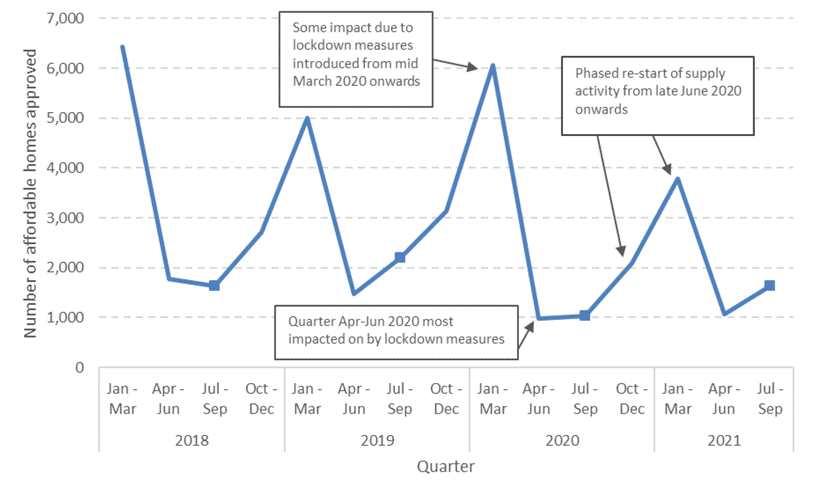
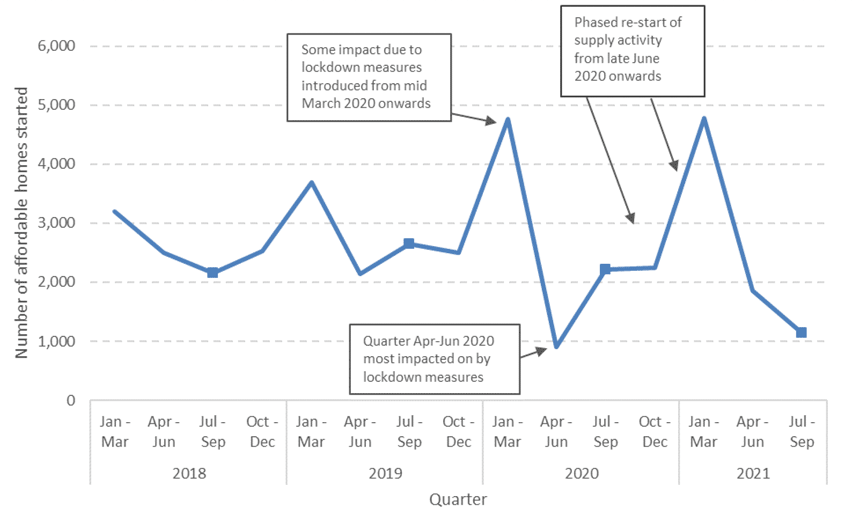
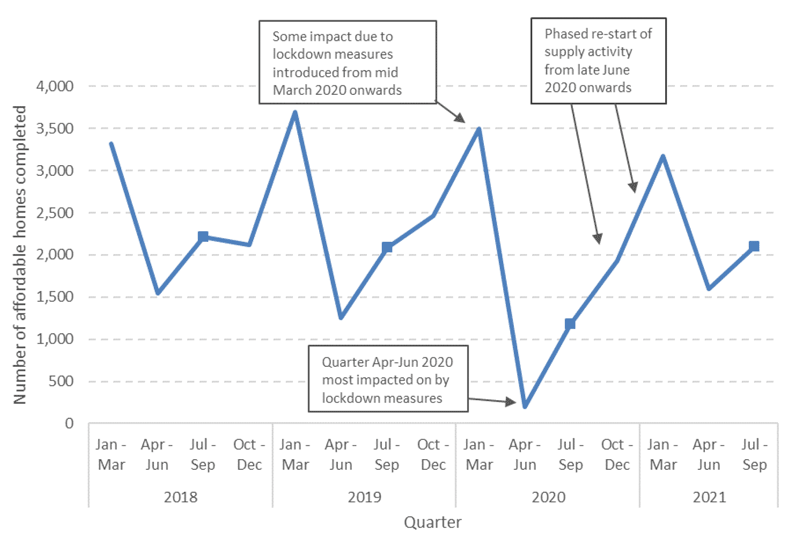
Chart 12 below shows that the numbers of affordable homes approved and started have decreased on an annual basis over the latest year to end September 2021 but the number of completions has increased in the same time period. In the year to end September 2021, 8,581 affordable homes were approved, a decrease of 2,626 homes (23%) on the previous year, and 10,023 homes were started, a decrease of 351 homes (3%), whilst 8,792 homes were completed, an increase of 1,464 homes (20%).
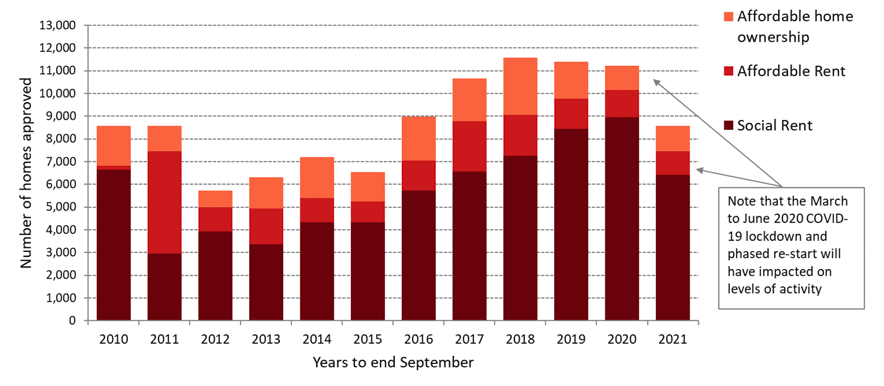
Charts 13 to 15 below present information on trends in affordable housing supply by type. Chart 13 shows that total affordable housing supply programme approvals decreased by 23% between 2020 and 2021 (years to end September). In the latest year 2021, social rent approvals accounted for 75% of all approvals, with affordable rent and affordable home ownership making up 12% and 13%, respectively, of the remaining total.
In the year to end September 2021, there were 6,408 homes approved for social rent, a decrease of 28% (2,545 homes) on the same period in 2020. There were 1,055 approvals for affordable rent, a decrease of 13% (153 homes), and 1,118 homes were approved for affordable home ownership, an increase of 7% (72 homes).
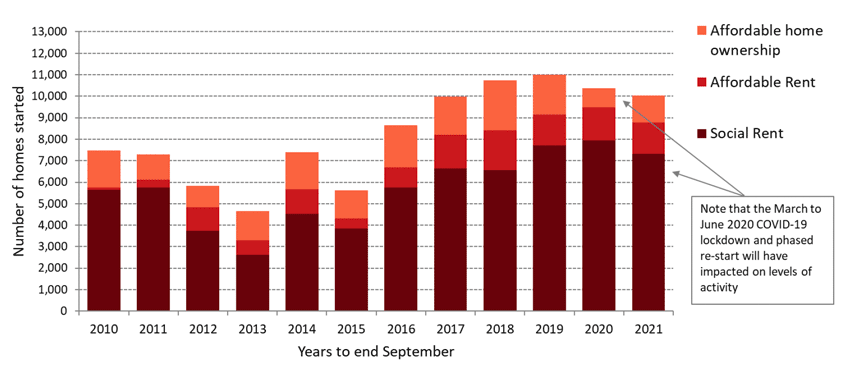
Chart 14 illustrates that total affordable housing supply programme starts decreased by 3% between 2020 and 2021 (years to end September). In the latest year, social rent starts accounted for 73% of all starts, with affordable rent and affordable home ownership making up 15% and 12% of the total, respectively.
In the year to end September 2021, there were 7,308 starts for social rent, a decrease of 8% (631 homes) on the previous year. There were 1,470 homes started for affordable rent, a drop of 5% (77 homes), and 1,245 homes were started for affordable home ownership, an increase of 40% (357 homes).
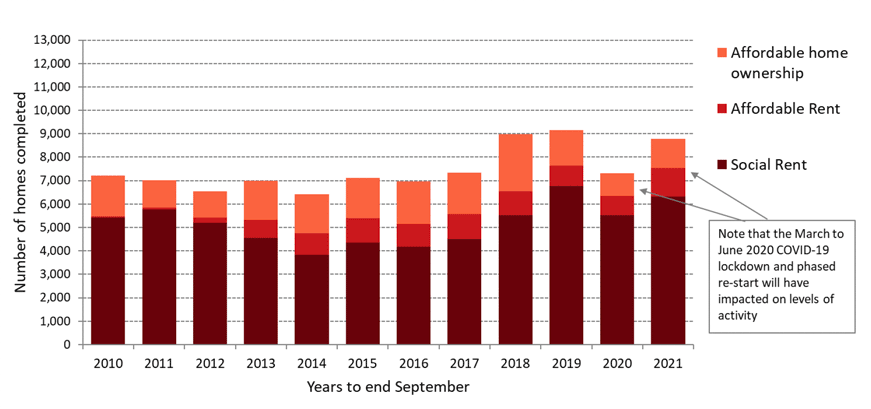
Chart 15 shows that total affordable housing supply programme completions increased by 20% between 2020 and 2021 (years to end September). In the latest year, social rent completions accounted for 72% of all completions, with affordable rent and affordable home ownership making up 14% and 14% of the total.
In the year to end September 2021, there were 6,329 homes completed for social rent, an increase of 15% (802 homes) on the previous year. There were 1,199 affordable rent homes completed, an increase of 46% (377 homes), and 1,264 homes completed for affordable home ownership, an increase of 29% (285 homes) on the previous year.

Comparison with the rest of the UK from 2007/08 to 2020/21
This section compares how the level of affordable housing supply per head of population varies between Scotland and other UK countries, to help meet user demand for cross country analysis.
Each of the countries of the UK produces their own statistics on affordable housing supply[6]. Whilst there are some differences in the detail of affordable housing definitions and products used by each country, some comparisons can be made on how affordable housing supply varies per head of population.
Chart 16 below illustrates how the figures per 10,000 population have varied across the 2007/08 to 2020/21 period for Scotland, England, Wales and Northern Ireland.
Between 2007/08 and 2019/20, the latest year in which there are figures available across all UK countries, the annual average supply of affordable housing per head of population in Scotland has been 13.8 homes per 10,000 population, higher than England (9.7 homes per 10,000 population), Wales (7.7 homes per 10,000 population), and Northern Ireland (13.0 homes per 10,000 population – average across the years 2010/11 to 2019/20). Scotland has had annual rates above all other UK countries in most years since 2007/08, except for during 2012/13 to 2014/15, in which the rates for Northern Ireland were higher.
The 6,477 affordable homes completed in Scotland in the financial year 2020/21 equates to a rate of 11.8 homes delivered per 10,000 population. This is above the rate of 9.2 in England. Affordable housing supply figures for 2020/21 for Wales and Northern Ireland are not yet available, however these will be added to Chart 16 in future publications.
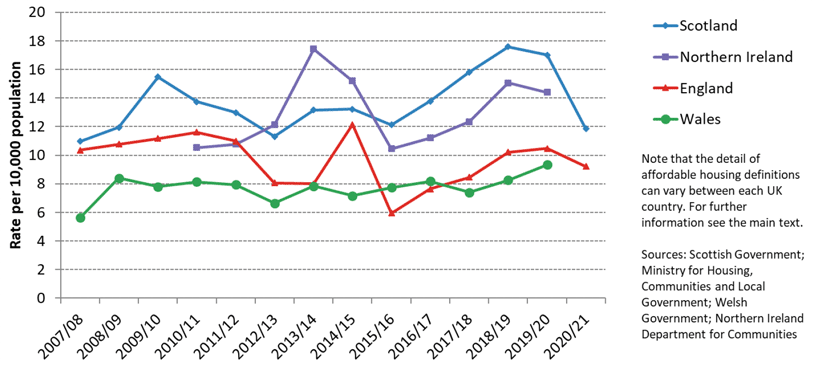
Note that the statistics for England and Wales both include developer-funded Section 106 supply, although for England it is thought that some will be missed as local authorities are not aware of it all. Northern Ireland does not currently have an equivalent mechanism. Data for Scotland include Section 75 units receiving some form of government funding. Data are not available to estimate the number of affordable homes delivered without central government funding in Scotland, but it is thought that the numbers of these homes may be relatively low based on current estimates of the number of funded Affordable and Section 75 homes being delivered.
In addition to the differences in total affordable supply between each country, there are also some differences in the use of different affordable housing products within the mix of overall affordable housing in each country. For example, in England in recent years there has been a greater use of affordable / intermediate rent compared to social rent. Therefore when looking over the four years to 2020/21, in England there have been on average 5.1 affordable / intermediate rent homes completed per 10,000 head of population and 1.1 social rented homes completed 10,000 per-head of population. This compares to a rate of 1.8 for affordable rent homes and a rate of 10.8 for social rented homes in Scotland.
Contact
There is a problem
Thanks for your feedback